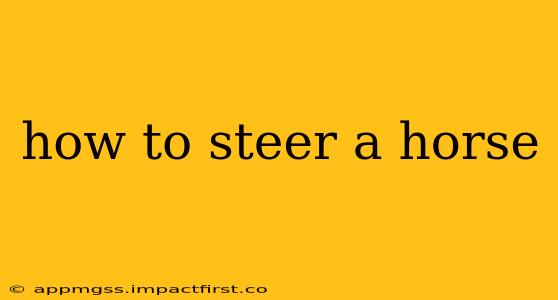Steering a horse might seem straightforward, but it's a nuanced skill requiring a delicate balance of communication, feel, and technique. This guide covers everything from the basics to more advanced maneuvers, ensuring you understand how to guide your equine partner safely and effectively.
What are the Basic Aids for Steering a Horse?
The primary aids for steering a horse are your seat, legs, and reins. Effective steering involves a subtle and coordinated use of all three. Riders often focus heavily on the reins, but a balanced approach using all aids results in a smoother, more responsive horse.
-
Seat: Your weight distribution significantly impacts the horse's direction. Shifting your weight slightly in the direction you want to go subtly influences the horse's balance and encourages turning.
-
Legs: Your legs act as directional cues. Applying gentle pressure with your inside leg (the leg closest to the direction you're turning) encourages the horse to bend and turn.
-
Reins: The reins provide more precise control. Using one rein (indirect rein) to guide the horse's head and neck is generally preferred over pulling on both simultaneously. Avoid harsh pulling; instead, focus on subtle cues.
How Do I Turn a Horse Left or Right?
Turning a horse involves a combination of the aids mentioned above. Here's a breakdown for both left and right turns:
Left Turn:
- Inside Leg: Apply gentle pressure with your left leg behind the girth. This encourages the horse's hindquarters to move towards the left.
- Outside Leg: Maintain a slight pressure with your right leg to prevent the horse from drifting away from the turn.
- Inside Rein: Use your left rein (indirect rein) to guide the horse's head and neck, gently easing the pressure as the horse responds.
Right Turn: Reverse the application of the aids from the left turn instructions.
How Much Rein Should I Use When Steering?
This depends greatly on the horse, the situation, and your experience. The goal is to achieve a balanced turn, without resorting to aggressive pulling on the reins. Over-reliance on the reins can lead to a resistant or even dangerous horse. Practice using your seat and legs first, adding rein pressure only as needed for refinement.
How Do I Steer a Horse Around Obstacles?
Steering around obstacles requires more precise use of your aids and anticipation. Begin by assessing the space available and the horse's reaction to the obstacle. Adjust your speed accordingly and use your aids smoothly to navigate the obstacle cleanly.
What if My Horse Doesn't Respond to My Steering Aids?
Several reasons can cause a horse to resist steering. This could include:
- Poor Training: A horse lacking proper training may not understand your cues.
- Rider Error: Incorrect application of the aids can confuse the horse.
- Physical Issues: A lameness or other physical issue could affect the horse's ability to move comfortably.
- Fear or Anxiety: The horse might be scared of something in its environment.
If you're experiencing persistent issues with steering, seeking guidance from an experienced riding instructor is crucial. They can help identify the underlying cause and provide tailored solutions.
What are Some Common Mistakes to Avoid When Steering a Horse?
- Pulling too hard on the reins: This can create resistance and tension.
- Using only the reins: Neglecting your seat and legs results in unbalanced turns.
- Inconsistent aids: The horse needs clear, consistent cues to understand what you want.
- Ignoring body language: Pay attention to your horse's reactions and adjust your approach accordingly.
Mastering the art of steering a horse takes time, practice, and patience. Remember to always prioritize safety and clear communication with your equine partner. With dedicated effort, you'll soon feel confident and in control when guiding your horse.
